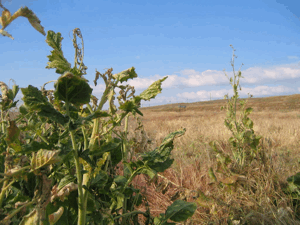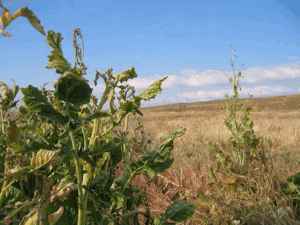The Spores of Sickness
Air Date: Week of April 30, 2010
 |
Valley Fever is a fungus that makes its way from dry dirt into the respiratory system and it’s rapidly spreading the central California and parts of the Southwest. As Living on Earth and Planet Harmony’s Mwende Hahsey (Hay-see) reports, experts say the fungus is especially harmful to African Americans and Hispanics.
Transcript
YOUNG: It’s Living on Earth, I’m Jeff Young. It’s called Coccidioidomycosis. Or to the layman, Valley Fever. It’s caused by an airborne fungus in some dry parts of the American west. Most often Valley Fever causes flu-like symptoms but for some it wreaks havoc throughout the body. It hits hardest among African- and Hispanic-Americans. Doctors think the reasons are both genetic and socioeconomic. Mwende Hahesy has the story.
HAHESY: Valley Fever isn't well known. Even within California and Arizona where it's found. Yet it's the most common and fastest growing infectious disease in Central California. And Valley Fever has made thousands of people really sick. People like Jonita Hodge. Back in 2006 her doctor told her:
HODGE: Doctor Amin Navinchandara says, there’s no medical reason you’re here. You better go to your prayer closet and thank someone!
[HODGE AND HAHESY LAUGH]
HAHESY: We met in northeast Bakersfield where she lives. It’s your typical California suburban neighborhood with wide streets and identical homes. Nearby construction churns up the dirt and with dirt cocci spores.
Jonita is a lifelong athlete. She’s coached basketball and volleyball for nearly 23 years, but her former six-foot self shrank when she lost an entire vertebra to the fungus. Her hair’s become so brittle it just breaks off. Now she wears a wig. The infection left her with scalely skin and painful bumps and scars all over her legs.
HODGE: Pain was—I had two kids complete natural birth and I’ll tell you it was worse.
HAHESY: Jonita’s doctor, Amin Navinchandara is an infectious disease specialist in Bakersfield, California. He says even though black and brown people make up 40 percent of Bakersfield’s population they account for 80 percent of serious Valley Fever cases that he sees. Only recently have researchers suggested that there may be a genetic reason why people of color suffer more from Valley Fever.
AMIN: It is usually biological because we think that this group of people probably have a gene in them, which doesn’t allow them to fight the fungus.

Johnita Hodge takes antibiotics every day to keep her Valley Fever subdued. (Photo: Mwende Hahesy)
HAHESY: Scientists haven’t pinpointed the biological reason minority populations get it worse…
AMIN: But, it can be environmental, as well.
HAHESY: The environmental and social factors are more obvious once you understand how people usually catch Valley Fever.
AMIN: When the soil is being disturbed, this particular fungus turns into a spore or a bubble.
HAHESY: These spore packs dislodge when people dig into the dirt.
[SOUND OF SHOVEL DIGGING]
AMIN: And this bubble comes into the air…
HAHESY: And with a puff of air…
[SOUNDS OF WIND]
HAHESY: The bubble pops open…
[POP!]
HAHESY: Releasing the cocci spores.
[SPRAYING SOUNDS]
AMIN: And all an individual need to do is inhale about ten to 15 spores.
HAHESY: A dozen spores can make you sick. Factor in a scary dust storm and we’re talking ten times the load needed.
[MULTIPLE POPS]

Valley Fever is a fast growing disease from the South West to Central California. (Photo: Mwende Hahesy)
HAHESY: Many brown-skinned people work in construction and agriculture. They’re the ones more likely to be around freshly stirred up spores. The infection starts off small, with a cough. Then gets worse the longer Valley Fever goes untreated, or as with Jonita, the longer it goes misdiagnosed.
HODGE: From 2003 to 2006 there was not one signal Valley Fever test. I had been tested for AIDS three times, I had been tested for every disease you can think of including sickle cell a couple of times, but full blood work does not include Valley Fever.
HAHESY: It took a friend’s vision to push Jonita to ask for a Valley Fever test.
HODGE: A friend of mine actually called me. She says, how you been feeling? Have you been sick? I say, as a matter of fact, I have been. And she said, I don’t want to scare you or anything, but the lord told me you have Valley Fever.
HAHESY: Valley Fever is easily treatable, especially if the infection hasn’t spread past the lungs. Amphotericin is one of the go-to antibiotics used to treat the infection.
HODGE: When you get a weed in your yard, if you get a little piece of it, if you don’t kill it right away, it will just take over your entire yard, and then you’ve got to come with Roundup and that’s what the amphotericin is basically Roundup. And what happens when you have a weed and it grows back? It comes back stronger.

Valley Fever spores thrive in the dry, alkaline soil, found in the southwest USA. (Photo: Mwende Hahesy)
HAHESY: Jonita has to take antibiotics for the rest of her life. Her body was so ravaged by the Valley Fever that it will return if she doesn’t. This scenario is playing out more and more often. Again, here’s doctor Amin.
AMIN: I came here in 1979; at that time we were seeing on an average about 200 cases a year. And now it has virtually run to 2,000 cases a year.
HAHESY: The effects of climate change may make the valley and the southwestern soil drier and more hospitable to the fungus. To those in the area doctor Amin has this advice:
AMEEN: When we ever have a dust storm, stay out of the wind. Don’t go out, particularly people who are in the high-risk group.
HAHESY: Currently, there is little funding for a vaccine. And not that many people are talking about prevention and treatment of Valley Fever. But doctors say without addressing these issues there will only be more cases like Jonita’s. For Planet Harmony and Living on Earth in Bakersfield, California. This is Mwende Hahesy.
[The Headhunters “Ms Yum Yum” from Straight From The Gate (Arista Records 1977)]
YOUNG: Mwende is a reporter from our brand new online offering, Planet Harmony, which welcomes all and is designed to have special appeal for young African-Americans. Check it out and join the discussion at My Planet Harmony dot com. That’s myplanetharmony dot com.
[The Headhunters “Ms Yum Yum” from Straight From The Gate (Arista Records 1977)]
Links
Living on Earth wants to hear from you!
Living on Earth
62 Calef Highway, Suite 212
Lee, NH 03861
Telephone: 617-287-4121
E-mail: comments@loe.org
Newsletter [Click here]
Donate to Living on Earth!
Living on Earth is an independent media program and relies entirely on contributions from listeners and institutions supporting public service. Please donate now to preserve an independent environmental voice.
NewsletterLiving on Earth offers a weekly delivery of the show's rundown to your mailbox. Sign up for our newsletter today!
 Sailors For The Sea: Be the change you want to sea.
Sailors For The Sea: Be the change you want to sea.
 The Grantham Foundation for the Protection of the Environment: Committed to protecting and improving the health of the global environment.
The Grantham Foundation for the Protection of the Environment: Committed to protecting and improving the health of the global environment.
 Contribute to Living on Earth and receive, as our gift to you, an archival print of one of Mark Seth Lender's extraordinary wildlife photographs. Follow the link to see Mark's current collection of photographs.
Contribute to Living on Earth and receive, as our gift to you, an archival print of one of Mark Seth Lender's extraordinary wildlife photographs. Follow the link to see Mark's current collection of photographs.
 Buy a signed copy of Mark Seth Lender's book Smeagull the Seagull & support Living on Earth
Buy a signed copy of Mark Seth Lender's book Smeagull the Seagull & support Living on Earth

